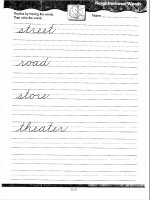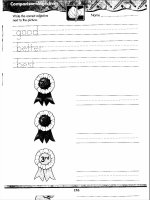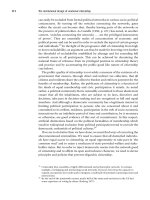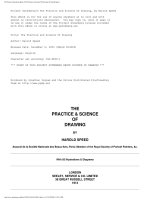The Practice & Science Of Drawing phần 6 docx
Bạn đang xem bản rút gọn của tài liệu. Xem và tải ngay bản đầy đủ của tài liệu tại đây (737.34 KB, 14 trang )
The Project Gutenberg eBook of The Practice & Science Of Drawing, by Harold Speed.
Diagram XI.
ILLUSTRATING, D, RHYTHMIC INFLUENCE OF VERTICAL LINES; E, THE INTRODUCTION OF SOME VARIETY; F, THE
DESTRUCTION OF THE VERTICAL AND CONSEQUENT LOSS OF REPOSE.
The rich modelling and swinging lines of the "Bacchus and Ariadne" of Titian in the National Gallery, here reproduced, page 154
[Transcribers Note: Plate XXXIV], would be too gross, were it not for the steadying influence of the horizontal lines in the sky and
the vertical lines of the tree-trunks.
While speaking of this picture, it might not be out of place to mention an idea that occurred to me as to the reason for the
somewhat aggressive standing leg of the female figure with the cymbals leading the procession of revellers. I will not attempt any
analysis of this composition, which is ably gone into in another book of this series. But the standing leg of this figure, given such
prominence in the composition, has always rather puzzled me. I knew Titian would not have given it that vigorous stand without a
good reason. It certainly does not help the run of the composition, although it may be useful in steadying it, and it is not a
particularly beautiful thing in itself, as the position is one better suited to a man's leg than to a woman's. But if you cover it over
with your finger and look at the composition without it, I think the reason of its prominence becomes plainer. Titian evidently had
some trouble, as well he might have, with the forward leg of the Bacchus. He wished to give the look of his stepping from the car
lightly treading the air, as gods may be permitted to do. But the wheel of the car that comes behind the foot made it difficult to
evade the idea that he was stepping on it, which would be the way an ordinary mortal would alight. I think the duty of the
aggressive standing leg of the leading Bacchante, with its great look of weight, is to give a look of lightness to this forward leg of
Bacchus, by contrast—which it certainly does. On examining the picture closely in a good light, you will see that he has had the
foot of Bacchus in several positions before he got it right. Another foot can distinctly be seen about a couple of inches or so above
the present one. The general vertical direction of this leg is also against its look of lightness and motion, tending rather to give it a
stationary, static look. I could not at first see why he did not bring the foot further to the right, which would have aided the
lightness of the figure and increased its movement. But you will observe that this would have hurled the whole weight of the mass
of figures on the right, forward on to the single figure of Ariadne, and upset the balance; as you can see by covering this leg with
your finger and imagining it swinging to the right. So that Titian, having to retain the vertical position for Bacchus' forward leg,
used the aggressive standing leg of the cymbal lady to accentuate its spring and lightness.
155
(71 of 147)3/9/2006 11:03:42 PM
The Project Gutenberg eBook of The Practice & Science Of Drawing, by Harold Speed.
Plate XXXIV.
BACCHUS AND ARIADNE. TITIAN
Photo Hanfstaengl
A feeling of straight-up-ness in a figure or of the horizontal plane in anything will produce the same effect as a vertical or
horizontal line without any actual line being visible. Blake's "Morning Stars Singing Together" is an instance of the vertical chord,
although there is no actual upright line in the figures. But they all have a vigorous straight-up-ness that gives them the feeling of
peace and elevation coupled with a flame-like line running through them that gives them their joyous energy.
Diagram XII.
A, B, C
The combination of the vertical with the horizontal produces one of the strongest and most arresting chords that you can make, and
it will be found to exist in most pictures and drawings where there is the expression of dramatic power. The cross is the typical
The Right Angle
156
(72 of 147)3/9/2006 11:03:42 PM
The Project Gutenberg eBook of The Practice & Science Of Drawing, by Harold Speed.
example of this. It is a combination of lines that instantly rivets the attention, and has probably a more powerful effect upon the
mind—quite apart from anything symbolised by it—than any other simple combinations that could have been devised. How
powerful is the effect of a vertical figure, or even a post, seen cutting the long horizontal line of the horizon on the sea-shore. Or a
telegraph post by the side of the road, seen against the long horizontal line of a hill at sunset. The look of power given by the
vertical lines of a contracted brow is due to the same cause. The vertical furrows of the brow continuing the lines of the nose, make
a continuous vertical which the horizontal lines of the brow cross (see Fig. A in the illustration). The same cause gives the profile a
powerful look when the eyebrows make a horizontal line contrasting with the vertical line of the forehead (Fig. B). Everybody
knows the look of power associated with a square brow: it is not that the square forehead gives the look of a larger brain capacity,
for if the forehead protrudes in a curved line, as at C, the look of power is lost, although there is obviously more room for brains.
This power of the right angle is well exemplified in Watts' "Love and Death," here reproduced, page 158 [Transcribers Note:
Plate
XXXV]. In this noble composition, in the writer's opinion one of the most sublime expressions produced by nineteenth-century art,
the irresistible power and majesty of the slowly advancing figure of Death is largely due to the right angle felt through the pose.
Not getting it in the contour, Watts has boldly introduced it by means of shading the farther arm and insisting on the light upper
edge of the outstretched arm and hand, while losing somewhat the, outline of the head beyond. Note also the look of power the
insistence on square forms in the drapery gives this figure. The expression is still further emphasised by the hard square forms of
the steps, and particularly by the strong horizontal line of the first step so insisted on, at right angles to the vertical stand of the
figure; and also the upright lines of the doorway above. In contrast with the awful sublimity of this figure of Death, how touching
is the expression of the little figure of Love, trying vainly to stop the inevitable advance. And this expression is due to the curved
lines on which the action of the figure is hung, and the soft undulating forms of its modelling. Whereas the figure of Death is all
square lines and flat crisp planes, the whole hanging on a dramatic right angle; this figure is all subtle fullness both of contour and
modelling melting one into the other, the whole hung upon a rich full curve starting at the standing foot of the advancing figure.
And whereas the expression of Death is supported and emphasised by the hard, square forms and texture of the stone steps, the
expression of Love is supported and emphasised by the rounded forms and soft texture of the clustering roses. On this contrast of
line and form, so in sympathy with the profound sentiment to which this picture owes its origin, the expressive power of this
composition will be found to depend.
Diagram XIII.
157159
(73 of 147)3/9/2006 11:03:42 PM
The Project Gutenberg eBook of The Practice & Science Of Drawing, by Harold Speed.
ILLUSTRATING SOME OF THE LINES ON WHICH THE RHYTHMIC POWER OF THIS PICTURE DEPENDS.
Plate XXXV.
LOVE AND DEATH. BY G.F. WATTS
A noble composition, founded on the power of the right angle in the figure of Death, in contrast with the curved lines in the figure of
Love. (See diagram opposite.)
Photo Hollyer
In the diagram accompanying the reproduction of this picture I have tried to indicate in diagrammatical form some of the chief
lines of its anatomy.
In these diagrams of the anatomy of compositions the lines selected are not always very obvious in the originals and are justly
much broken into by truths of natural appearance. But an emotional significance depending on some arrangement of abstract lines
is to be found underlying the expression in every good picture, carefully hidden as it is by all great artists. And although some
apology is perhaps necessary for the ugliness of these diagrams, it is an ugliness that attends all anatomy drawings. If the student
will trace them and put his tracing over the reproductions of the originals, they will help him to see on what things in the
arrangement the rhythmic force of the picture depends.
Other lines, as important as those selected, may have been overlooked, but the ones chosen will suffice to show the general
character of them all.
(74 of 147)3/9/2006 11:03:42 PM
The Project Gutenberg eBook of The Practice & Science Of Drawing, by Harold Speed.
There is one condition in a composition, that is laid down before you begin, and that is the shape of your panel or canvas. This is
usually a rectangular form, and all the lines of your design will have to be considered in relation to this shape. Vertical and
horizontal lines being parallel to the boundaries of rectangular pictures, are always right and immediately set up a relationship, as
we have seen.
The arresting power of the right angle exists at each corner of a rectangular picture, where the vertical sides meet the horizontal
base, and this presents a difficulty, because you do not wish the spectator's attention drawn to the corners, and this dramatic
combination of lines always attracts the eye. A favourite way of getting rid of this is to fill them with some dark mass, or with
lines swinging round and carrying the eye past them, so that the attention is continually swung to the centre of the picture. For
lines have a power of directing the attention, the eye instinctively running with them, and this power is of the greatest service in
directing the spectator to the principal interest.
It is this trouble with the corners that makes the problem of filling a square so exacting. In an ordinary rectangular panel you have
a certain amount of free space in the middle, and the difficulty of filling the corners comfortably does not present itself until this
space is arranged for. But in a square, the moment you leave the centre you are in one or other of the corners, and the filling of
them governs the problem much more than in the case of other shapes. It is a good exercise for students to give themselves a
square to fill, in order to understand this difficulty and learn to overcome it.
Other lines that possess a direct relation to a rectangular shape are the diagonals. Many compositions that do not hang on a vertical
or horizontal basis are built on this line, and are thus related to the bounding shape.
Plate XXXVI.
THE SURRENDER OF BREDA VELAZQUEZ (PRADO)
Photo Anderson
When vertical, horizontal, or diagonal lines are referred to, it must not be assumed that one means in all cases naked lines. There is
no pure vertical line in a stone pine or cypress tree, nor pure horizontal line in a stretch of country, but the whole swing of their
lines is vertical or horizontal. And in the same way, when one speaks of a composition being hung upon a diagonal, it is seldom
that a naked diagonal line exists in the composition, but the general swing is across the panel in harmony with one or other
diagonal. And when this is so, there is a unity set up between the design and its boundaries. A good instance of vertical, horizontal,
and diagonal lines to unite a picture is Velazquez's "The Surrender of Breda," here reproduced. Note the vertical chord in the
spears on the left, continued in the leg of the horse and front leg of the figure receiving the key, and the horizontal line made by the
dark mass of distant city, to be continued by the gun carried over the shoulder of the figure with the slouch hat behind the principal
group. Velazquez has gone out of his way to get this line, as it could hardly have been the fashion to carry a gun in this position,
pointing straight at the head of the man behind. Horizontal lines also occur in the sky and distant landscape, one running right
through the group of spears. The use of the diagonal is another remarkable thing in the lines of this picture. If you place a ruler on
the slanting line of the flag behind the horse's head to the right, you find it is exactly parallel to a diagonal drawn from the top right-
160
161162
(75 of 147)3/9/2006 11:03:42 PM
The Project Gutenberg eBook of The Practice & Science Of Drawing, by Harold Speed.
hand corner to the lower left-hand corner. Another line practically parallel to this diagonal is the line of the sword belonging to the
figure offering the key, the feeling of which is continued in the hand and key of this same figure. It may be noted also that the back
right leg of the horse in the front is parallel to the other diagonal, the under side of it being actually on the diagonal and thus
brought into relation with the bounding lines of the picture. And all these lines, without the artifice being too apparent, give that
well-knit, dignified look so in harmony with the nature of the subject.
Curved lines have not the moral integrity of straight lines. Theirs is not so much to minister to the expression of the sublime as to
woo us to the beauteous joys of the senses. They hold the secrets of charm. But without the steadying power of straight lines and
flatnesses, curves get out of hand and lose their power. In architecture the rococo style is an example of this excess. While all
expressions of exuberant life and energy, of charm and grace depend on curved lines for their effect, yet in their most refined and
beautiful expression they err on the side of the square forms rather than the circle. When the uncontrolled use of curves
approaching the circle and volute are indulged in, unrestrained by the steadying influence of any straight lines, the effect is gross.
The finest curves are full of restraint, and excessive curvature is a thing to be avoided in good drawing. We recognise this integrity
of straight lines when we say anybody is "an upright man" or is "quite straight," wishing to convey the impression of moral worth.
Rubens was a painter who gloried in the unrestrained expression of the zeal to live and drink deeply of life, and glorious as much
of his work is, and wonderful as it all is, the excessive use of curves and rounded forms in his later work robs it of much of its
power and offends us by its grossness. His best work is full of squarer drawing and planes.
Always be on the look out for straightnesses in curved forms and for planes in your modelling.
Let us take our simplest form of composition again, a stretch of sea and sky, and apply curved lines where we formerly had
straight lines. You will see how the lines at A, page 164 [Transcribers Note:
Diagram XIV], although but slightly curved, express
some energy, where the straight lines of our former diagram expressed repose, and then how in B and C the increasing curvature of
the lines increases the energy expressed, until in D, where the lines sweep round in one vigorous swirl, a perfect hurricane is
expressed. This last, is roughly the rhythmic basis of Turner's "Hannibal Crossing the Alps" in the Turner Gallery.
One of the simplest and most graceful forms the tying lines of a composition may take is a continuous flow, one line evolving out
of another in graceful sequence, thus leading the eye on from one part to another and carrying the attention to the principal
interests.
Two good instances of this arrangement are Botticelli's "Birth of Venus" and the "Rape of Europa," by Paolo Veronese,
reproduced on pages 166 [Transcribers Note:
Diagram XV, Plate XXXVII] and 168 [Transcribers Note: Diagram XVI, Plate
XXXVIII]. The Venetian picture does not depend so much on the clarity of its line basis as the Florentine. And it is interesting to
note how much nearer to the curves of the circle the lines of Europa approach than do those of the Venus picture. Were the same
primitive treatment applied to the later work painted in the oil medium as has been used by Botticelli in his tempera picture, the
robustness of the curves would have offended and been too gross for the simple formula; whereas overlaid and hidden under such
a rich abundance of natural truth as it is in this gorgeous picture, we are too much distracted and entertained by such wealth to
have time to dwell on the purity of the line arrangement at its base. And the rich fullness of line arrangement, although rather
excessive, seen detached, is in keeping with the sumptuous luxuriance the Venetian loved so well to express. But for pure line
beauty the greater restraint of the curves in Botticelli's picture is infinitely more satisfying, though here we have not anything like
the same wealth and richness of natural appearance to engage our attention, and the innocent simplicity of the technique leaves
much more exposed the structure of lines, which in consequence play a greater part in the effect of the picture.
Curved Lines
163
167
(76 of 147)3/9/2006 11:03:42 PM
The Project Gutenberg eBook of The Practice & Science Of Drawing, by Harold Speed.
Diagram XIV.
ILLUSTRATING POWER OF CURVED LINES TO CONVEY ENERGY. A, B, C, D.
(77 of 147)3/9/2006 11:03:42 PM
The Project Gutenberg eBook of The Practice & Science Of Drawing, by Harold Speed.
Diagram XIV.
ILLUSTRATING POWER OF CURVED LINES TO CONVEY ENERGY. A, B, C, D.
Diagram XV.
ILLUSTRATING THE FLOW OF LINES ON WHICH THE RHYTHMIC UNITY OF THIS PICTURE DEPENDS.
Plate XXXVII.
THE BIRTH OF VENUS. BOTTICELLI (FLORENCE)
A beautiful example of Botticelli's refined line rhythm. (See diagram on opposite page for analysis.)
(78 of 147)3/9/2006 11:03:42 PM
The Project Gutenberg eBook of The Practice & Science Of Drawing, by Harold Speed.
Photo Anderson
In both cases note the way the lines lead up to the principal subject, and the steadying power introduced by means of horizontal,
vertical, and other straight lines. Veronese has contented himself with keeping a certain horizontal feeling in the sky, culminating
in the straight lines of the horizon and of the sea edge. And he has also introduced two pyramids, giving straight lines in among the
trees, the most pronounced of which leads the eye straight on to the principal head.
Botticelli has first the long line of the horizon echoed in the ground at the right-hand lower corner. And then he has made a
determined stand against the flow of lines carrying you out of the picture on the right, by putting straight, upright trees and
insisting upon their straightness.
Diagram XVI.
ILLUSTRATING SOME OF THE MAIN LINES ON WHICH THE RHYTHMIC UNITY OF THIS PICTURE DEPENDS.
(79 of 147)3/9/2006 11:03:42 PM
The Project Gutenberg eBook of The Practice & Science Of Drawing, by Harold Speed.
Plate XXXVIII.
THE RAPE OF EUROPA. BY PAOLO VERONESE (VENICE)
A composition of rich full forms and rich full colour. (See the diagram on opposite page for analysis of line rhythm.)
Photo Anderson
Another rhythmic form the lines at the basis of a composition may take is a flame-like flow of lines; curved lines meeting and
parting and meeting again, or even crossing in one continual movement onwards. A striking instance of the use of this quality is
the work of the remarkable Spanish painter usually called El Greco, two of whose works are here shown (page 172 [Transcribers
Note:
Plate XL]). Whatever may be said by the academically minded as to the incorrectness of his drawing, there can be no two
opinions as to the remarkable rhythmic vitality of his work. The upward flow of his lines and the flame-like flicker of his light
masses thrills one in much the same way as watching a flaring fire. There is something exalting and stimulating in it, although,
used to excess as he sometimes uses it, it is apt to suffer from lack of repose. Two examples of his pictures are reproduced here,
and illustrate his use of this form of movement in the lines and masses of his compositions. Nowhere does he let the eye rest, but
keeps the same flickering movement going throughout all his masses and edges. The extraordinary thing about this remarkable
painter is that while this restless, unrestrained form of composition makes his work akin to the rococo work of a later period, there
is a fiery earnestness and sincerity in all he does, only to be matched among the primitive painters of the fourteenth and fifteenth
centuries, and very different from the false sentiment of the later school.
Blake was also fond of this flame line, but usually used it in combination with more straight lines than the energetic Spaniard
allowed himself. Plates III and V in the Job series are good examples of his use of this form. In both cases it will be seen that he
uses it in combination with the steadying influence of straight lines, which help to keep the balance and repose necessary in the
treatment of even the most violent subjects in art.
A continual interruption in the flow of lines, and a harsh jarring of one against another in an angular, jagged fashion, produces a
feeling of terror and horror. A streak of fork lightning is a natural example of this. The plate of Blake's No. XI, p. 148
[Transcribers Note:
Plate XXXII], reproduced here, is also a good example. I have had it put sideways on so that you may see that
the look of horror is not only in the subject but belongs to the particular music of line in the picture. The effect of the harsh
contrasts in the lines is further added to by the harsh contrasts of tone: everywhere hard lights are brought up against hard darks.
Harsh contrasts of tone produce much the same look of terror as harsh contrasts of line. Battle pictures are usually, when good, full
of these clashes of line and tone, and thrilling dramatic effects in which a touch of horror enters are usually founded on the same
principle. In the picture by Paolo Uccello in the National Gallery, reproduced on page 170 [Transcribers Note:
Plate XXXIX], a
milder edition of this effect is seen. The artist has been more interested in the pageantry of war and a desire to show off his newly-
acquired knowledge of perspective, than anything very terrible. The contrasts of line are here but confined to the smaller parts, and
there are no contrasts of light and shade, chiaroscuro not being yet invented. However, it will be seen by the accompanying
diagram how consistently the harsh contrasts of line were carried out in the planning of this picture. Notice the unconscious
humour of the foreshortened spears and figure carefully arranged on the ground to vanish to the recently discovered vanishing
point.
169
171
(80 of 147)3/9/2006 11:03:42 PM
The Project Gutenberg eBook of The Practice & Science Of Drawing, by Harold Speed.
Diagram XVII.
SHOWING THE CLASH OF LINES IN SYMPATHY WITH THE MARTIAL NATURE OF THIS SUBJECT.
Plate XXXIX.
BATTLE OF ST. EGIDIO. PAOLO UCCELLO (NATIONAL GALLERY)
Illustrating the effect of jarring lines in composition. (See diagram on opposite page.)
Photo Morelli
Lines radiating in smooth curves from a common centre are another form employed to give unity in pictorial design. The point
172
(81 of 147)3/9/2006 11:03:42 PM
The Project Gutenberg eBook of The Practice & Science Of Drawing, by Harold Speed.
from which they radiate need not necessarily be within the picture, and is often considerably outside it. But the feeling that they
would meet if produced gives them a unity that brings them into harmonious relationship.
There is also another point about radiating lines, and that is their power of setting up a relationship between lines otherwise
unrelated. Let us try and explain this. In Panel A, page 174 [Transcribers Note:
Diagram XVIII], are drawn some lines at random,
with the idea of their being as little related to each other as possible. In B, by the introduction of radiating lines in sympathy with
them, they have been brought into some sort of relationship. The line 1-2 has been selected as the dominating line, and an
assortment of radiating ones drawn about it. Now, by drawing 7-8, we have set up a relationship between lines 3-4, 5-6, and 1-2,
for this line radiates with all of them. Line 9-10 accentuates this relationship with 1-2. The others echo the same thing. It is this
echoing of lines through a composition that unites the different parts and gives unity to the whole.
The crossing of lines at angles approaching the right angle is always harsh and somewhat discordant, useful when you want to
draw attention dramatically to a particular spot, but to be avoided or covered up at other times. There is an ugly clash of crossing
lines in our original scribble, and at C we have introduced a mass to cover this up, and also the angles made by line 3-4 as it
crosses the radiating lines above 1-2. With a small mass at 11 to make the balance right, you have a basis for a composition,
Diagram C, not at all unpleasing in arrangement, although based on a group of discordant lines drawn at random, but brought into
harmony by means of sympathetic radiation.
Plate XL.
THE ASCENSION OF CHRIST. BY DOMINICO THEOTOCOPULI CALLED EL GRECO.
Note the flame-like form and flow of the light masses, and the exalted feeling this conveys.
Photo Anderson
(82 of 147)3/9/2006 11:03:42 PM
The Project Gutenberg eBook of The Practice & Science Of Drawing, by Harold Speed.
Plate XLI.
THE BAPTISM OF CHRIST. BY DOMINICO THEOTOCOPULI CALLED EL GRECO
Another example of his restless, flame-like composition.
Photo Anderson
In Panel D the same group is taken, but this time line 3-4 is used as the dominant one. Line 7-8 introduces 3-4 to 1-2, as it is
related to both. Lines 9-10 and 11-12 introduce 3-4 to 5-6, as they are related to both, and the others follow on the same principle.
By introducing some masses covering up the crossings, a rhythmic basis for a composition (Diagram E) entirely different from C
is obtained, based on the same random group.
In Panel F, 1-2 has been taken as the dominant line, and sympathetic lines drawn on the same principle as before. By again
covering the crossings and introducing balancing masses we obtain yet another arrangement from the same random scribble.
I would suggest this as a new game to students, one giving another two or three lines drawn in a panel at random, the problem
being to make harmonious arrangements by the introduction of others radiating in sympathy.
Often in a picture certain conditions are laid down to start with; something as ugly as our original group of lines drawn at random
has to be treated pictorially, and it is by means such as here suggested that its discordancy can be subdued and the whole brought
into harmony with the shape of your panel. The same principles apply in colour, discordant notes can be brought into harmony by
the introduction of others related to both the original colours, thus leading the eye from one to the other by easy stages and
destroying the shock. Somewhat in the way a musician will take you from one key into another very remote by means of a few
chords leading from the one to the other; whereas, had he taken you straight there, the shock would have been terrible. As it is,
these transitions from one key into another please and surprise one, and are very effective.
173
175
(83 of 147)3/9/2006 11:03:42 PM
The Project Gutenberg eBook of The Practice & Science Of Drawing, by Harold Speed.
Diagram XVIII.
SHOWING HOW LINES UNRELATED CAN BE BROUGHT INTO HARMONY BY THE INTRODUCTION OF OTHERS IN
SYMPATHY WITH THEM.
A. LINES DRAWN AT RANDOM.
B. TAKING LINE 1-2 AS DOMINANT LINE.
C. AS AT B BUT WITH ADDITION OF MASSES TO COVER LINES CROSSING AND RESTORE BALANCE
D. TAKING LINE 3-4 AS DOMINANT LINE
E. AS AT D BUT WITH ADDITION OF MASSES TO COVER LINES CROSSING AND GIVE BALANCE
F. TAKING LINE 5-6 AS DOMINANT LINE
G. AS AT F BUT WITH MASSES TO COVER LINES CROSSING & TO GIVE BALANCE
(84 of 147)3/9/2006 11:03:42 PM









